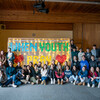It was 1941 and the American Volunteer Group, the Flying Tigers, was in China to help slow or repel the Japanese invasion. Paulene Barnett and her husband Doyle were young missionaries who had gone to China in the fall of 1940 along with several other couples. This group had been sent to Burma to get away from the Japanese invasion and to study the Chinese language for a year. Then in an epic journey that took two months, they traveled the Burma Road from Rangoon to Kunming, headquarters of General Claire L. Chennault and the Flying Tigers.
One day Paulene and Helen Lee, another missionaries' wife, were invited to a Flying Tigers party. After dinner, the music started and General Chennault came over and asked Paulene to dance with him. She said, "I'm sorry, I don't even know how to dance." He said, "Come on, I'll show you. This will be your first lesson." "He just put his arm around me quite tight and said ‘Here let me show you, it is quite easy to dance.' "I said, 'but I would love to see you dance with someone your equal who really knows how. It's so kind of you to ask me and I do thank you.' His reply was so gracious as he said, ‘Well, why don't we just sit down and visit for a while.' Much to my surprise we had an interesting visit which continued for about an hour. It is an unforgettable memory."
Doyle and Paulene met at Southwestern Junior College, were married in 1940 and two weeks later started their journey to Shanghai. They served in China and Taiwan more than 23 years. Paulene began her Sabbath School work in Taiwan, visiting churches and training leaders to teach children's Sabbath Schools. In 1963, Paulene went to Singapore and became the Southeast Asia Union Sabbath School director. Here is her story in her own words.
While traveling in Sabah, Borneo, I went to a one-room church packed with people sitting on sawhorse benches. My first impression was that it was the noisiest church I had ever been in. The teacher was shouting above the din of the noise. Babies were crying, boys and girls of all ages were in the aisle. Fortunately I didn't have to yell when I spoke. The translator took care of that. During the preliminaries, I had a chance to count the number of children. There were at least 98.
When the church service was over, I asked to meet with the elders and leaders in the church. I told them that I was concerned that these children were not hearing about the love of Jesus. The leaders agreed that they would like to teach their children, but they said, "You can see we have no place for them, not even a tree for them to sit under for shade from the hot sun and no place for them when the downpours of rain come. What can we do?"
Back in my office in Singapore while writing programs for all the children's Sabbath Schools, one Bible verse caught my full attention. Jesus questioned Peter three times: "Do you love me?" He answered, "Yes, Lord, you know I love you." Jesus said to him, "Then feed my lambs."
The picture of that country church with 98 children not being fed flooded my mind. But how can we feed the children if they have no shelter from the hot tropical sun and heavy downpours of rain?
Several letters were on my desk one day when I entered my office, one from my mother and the other from my "second mother," Abbie Dun, who served in China until her retirement. As I opened Mother's letter, a check for $25 fell out. The letter said, "Take this check and do something for the children." A check for $25 was in the other letter and the message was, ‘Use this to help the children.'
I sent the money to the most aggressive worker we had in Borneo asking him to build the best house shelter for the children to use on Sabbath. In less than a month he sent me a telegram giving the date and time the Lamb Shelter would be ready for dedication. I was there.
The Lamb Shelter was far better than expected. The little gate had a beautiful pink ribbon across it for the official opening. The children rushed in for a seat. Some of the adults started to go in but they were stopped. It was explained that this "church building" was for children only.
After the service, a tribal man with an interpreter called me over to the side and began to point. "See that hill across this deep valley. There's a white house on top of that hill. That's my church. Come to my village and make us a Lamb Shelter too.
Flying home to Singapore my mind was working overtime. We have no money to build Lamb Shelters. But they are so desperately needed. We needed them quickly. Those precious children are growing up with no relationship with God. The parents don't know how to teach them the Bible.
More requests for Lamb Shelters were waiting on my desk when I entered my office. The members were already getting wood prepared for the building, but they did not have the money for the galvanized roof. The next day the mail came and included several letters from people I did not know and all had checks in them. One even had $100 for a Lamb Shelter. Requests came flooding in for Lamb Shelters from other places in Sabah and then from all over the Far Eastern Division. The idea came to me, why don't we promise that if they will provide the structure, we will provide the galvanized roofing?
From that first Lamb Shelter built in Sabah, Borneo, during 1967, the idea of providing Sabbath School shelters for children spread all through Sarawak, Malaysia, Indonesia and the Philippines. Many of the children who went to Sabbath School in the Lamb Shelters are now active members of the church.
In 1976 Doyle and Paulene were called to the Far Eastern Division where Doyle was the Stewardship and Personal Ministries director and Paulene was the Division Sabbath School director and where she continued her work providing Lamb Shelters. They retired in 1983 after serving 42 years as missionaries in China and the Far East and now live in Walla Walla, Washington.







